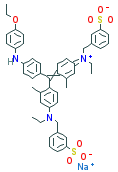|
BRILLIANT BLUE G |
| Synonyms. Brilliant Blue G; C.I. Acid Blue 90; Coomassie brilliant blue; Hydrogen (4-(4-(p-ethoxy anilino)-4'-(ethyl(m-sulphonatobenzyl) amino)-2'-methylbenzhydrylene)-3-methyl cyclohexa- 2,5-dien -1-ylidene)(ethyl)(m-sulphonatobenzyl)ammonium monosodium salt; Coomassie Brilliant Blue G; C.I. 42655; Brilliant Blue Gand G 250; Xylene Brilliant Cyanin G; |
|
|
| PRODUCT IDENTIFICATION | |
|
CAS RN |
6104-58-1 |
|
EINECS RN |
228-058-4 |
|
FORMULA |
C47H48N3NaO7S2 |
|
MOLE WEIGHT |
854.02 |
|
H.S CODE |
3204.12.2000 |
|
SMILES |
C(=C1\C(=C/C(=[N+](/Cc2cc(ccc2)S(=O)(=O)[O-])CC)C=C1)C) (\c1c( cc(cc1) N(Cc1cc(ccc1)S(=O)(=O)O)CC)C)c1ccc(cc1)Nc1ccc (cc1)OC C.[Na+] |
|
CLASSIFICATION |
P2X Receptor Modulator, Indicator and Reagent, Coloring agent |
|
EXTRA NOTES |
Other RN: 55965-18-9, 93907-61-0, 107120-23-0, 167396-16-9 |
|
|
| PHYSICAL AND CHEMICAL PROPERTIES | |
|
PHYSICAL STATE. |
dark blue crystalline powder |
|
MELTING POINT |
>100 C |
|
BOILING POINT |
|
|
DENSITY |
|
|
SOLUBILITY IN WATER |
40 g/l |
| SOLVENT SOLUBILITY |
Soluble in methanol, ethanol |
|
VAPOR DENSITY |
|
|
log P(octanol-water) |
|
|
VAPOR PRESSURE |
|
|
AUTOIGNITION TEMP |
|
| pK |
|
|
REFRACTIVE INDEX |
|
|
FLASH POINT |
|
|
|
| STABILITY AND REACTIVITY | |
| STABILITY | Stable under normal conditions. |
|
INCOMPATIBLE MATERIALS |
Strong acids, Strong oxidizing agents |
| POLYMERIZATION |
Has not been reported |
|
NFPA RATINGS |
Health: 0, Flammability: 0, Reactivity: 0 |
|
|
| EXTERNAL LINKS & GENERAL DESCRIPTION |
|
Wikipedia Linking - Coomassie Brilliant Blue Google Scholar Search - Brilliant Blue G Drug Information Portal (U.S. National Library of Medicine) - Brilliant Blue G PubChem Compound Summary - Brilliant Blue G KEGG (Kyoto Encyclopedia of Genes and Genomes) - Brilliant Blue G http://www.ncbi.nlm.nih.gov/ - Brilliant Blue G |
|
|
| SALES SPECIFICATION | |
|
APPEARANCE |
dark blue crystalline powder |
|
DYE CONTENT |
60% min |
|
LOSS ON DRYING |
10% max |
|
ABSORPTION |
608 ~ 618 nm (in 50:50 IMS:H2O) |
|
|
| TRANSPORT & REGULATORY INFORMATION | |
|
UN NO. |
|
| HAZARD CLASS |
|
| PACKING GROUP | |
|
|
| SAFETY INFORMATION | |
|
HAZARD OVERVIEW |
Not a dangerous substance according to GHS. Eyes: May cause eye irritation. Skin: May be harmful if absorbed through skin. May cause skin irritation. Inhalation: May be harmful if inhaled. May cause respiratory tract irritation. Ingestion: May be harmful if swallowed. |
| SIGNAL WORD | |
|
PICTOGRAMS |
|
|
HAZARD STATEMENTS |
|
|
P STATEMENTS |
|
| EC DIRECTIVES |
|
| HAZARD CODES |
|
|
RISK PHRASES |
|
|
SAFETY PHRASES |
22-24/25 |
|
|
| PACKING |
|
Preserve in light-resistant and well-closed containers |
|
|
